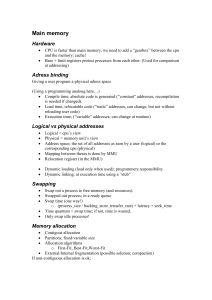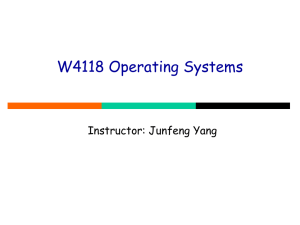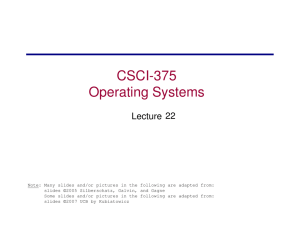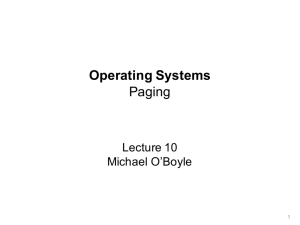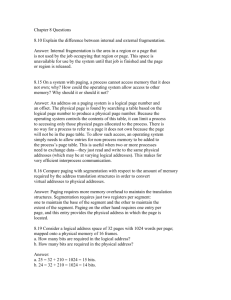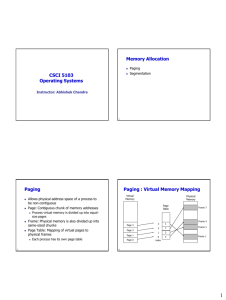Paging
advertisement
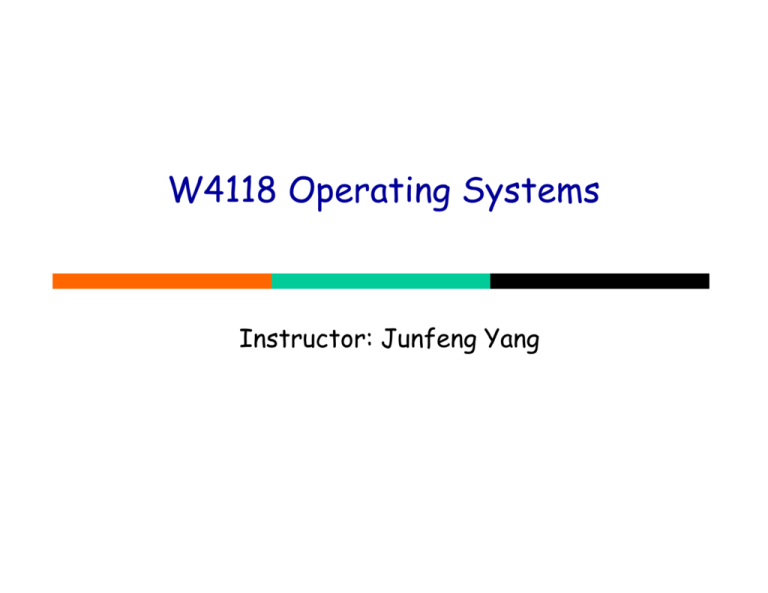
W4118 Operating Systems Instructor: Junfeng Yang Outline Paging Overview Page translation Page allocation Page protection Translation Look-aside Buffers (TLB) Page sharing Page table structure Combining paging with segmentation 1 Paging overview Goal Paging: divide memory into fixed-sized pages Eliminate external fragmentation Don’t allocate memory that will not be used Enable sharing Both virtual and physical memory are composed of pages Another terminology A virtual page: page A physical page: frame 2 Page translation Address bits = page number + page offset Translate virtual page number (vpn) to physical page number (ppn) using page table pa = page_table[va/pg_sz] + va%pg_sz CPU vpn off vpn ppn off ppn ppn Page table Memory 3 Page translation example Page 0 Page 1 Page 2 Page 3 Virtual Memory 0 1 1 4 2 3 Page 2 3 7 Page 1 Page 0 Page table Page 3 Physical Memory 4 Page translation exercise 8-bit virtual address, 10-bit physical address, and each page is 64 bytes How many virtual pages? How many physical pages? How many entries in page table? Given page table = [2, 5, 1, 8], what’s the physical address for virtual address 241? m-bit virtual address, n-bit physical address, k-bit page size What are the answers to the above questions? 5 Page protection Implemented by associating protection bits with each virtual page in page table Protection bits valid bit: map to a valid physical page? read/write/execute bits: can read/write/execute? Checked by MMU on each memory access 6 Page protection example vrwe Page 0 Page 1 Page 3 Virtual Memory 0 1 1 4 1110 2 3 0000 3 7 1111 1100 Page 0 Page 1 Page table Page 3 Physical Memory 7 Page allocation Free page management E.g., can put page on a free list Allocation policy free_page_list Page 0 E.g., one page at a time, from head of free list Page 1 Page 3 2, 3, 6, 5, 0 8 Implementation of page table Page table is stored in memory Page table base register (PTBR) points to the base of page table OS stores the value of this register in process control block (PCB) OS switches PTBR on each context switch Problem: each data/instruction access requires two memory accesses Extra memory access for page table 9 Avoiding extra memory access Fast-lookup hardware cache called associative memory or translation lookaside buffers (TLBs) Fast parallel search (CPU speed) Small VPN PPN 10 Paging hardware with TLB 11 TLB Miss Can be handled in hardware and software Hardware (CISC: x86) Pros: hardware doesn’t have to trust OS ! Cons: complexity Software (RISC: MIPS, SPARC) Pros: flexibility Cons: code may have bug Question: what can’t a TLB miss handler do? 12 TLB and context switches What happens to TLB on context switches? Option 1: flush entire TLB x86 Option 2: attach process ID to TLB entries ASID: Address Space Identifier MIPS, SPARC 13 Effective access time Associative Lookup = ε time unit Assume memory cycle time is 1 ms Hit ratio – α Percentage of times that a page number is found in the associative registers; ratio related to number of associative registers Effective Access Time (EAT) EAT = (1 + ε) α + (2 + ε)(1 – α) = α + εα + 2 + ε - εα - 2α =2+ε–α 14 Motivation for page sharing Efficient communication. Processes communicate by write to shared pages Memory efficiency. One copy of read-only code/data shared among processes Example 1: multiple instances of the shell program Example 2: parent and forked child share AS 15 Page sharing example 16 Page table size issues Given: A 32 bit address space (4 GB) 4 KB pages A page table entry of 4 bytes Implication: page table is 4 MB per process! Observation: address space are often sparse Few programs use all of 2^32 bytes Change page table structures to save memory Trade translation time for page table space 17 Page table structures Hierarchical paging Hashed page tables Inverted page tables 18 Hierarchical page table Break up virtual address space into multiple page tables at different levels 19 Two-level paging example 32-bit address space, 4 KB page How many bits for 2nd-level page table? 4KB page 12 bits for page offset Desirable to fit a 2nd-level page table in one page 4KB/4B = 1024 10 bits for 2nd-level page table Address bits for top-level page table: 32 – 12 – 12 = 10 page number pi 10 p2 10 page offset d 12 20 Address-translation scheme 21 Hashed page table Common in address spaces > 32 bits Page table contains a chain of elements hashing to the same location On page translation Hash virtual page number into page table Search chain for a match on virtual page number 22 Hashed page table example 23 Inverted page table One entry for each real page of memory Entry consists of the virtual address of the page stored in that real memory location, with information about the process that owns that page Can use hash table to limit the search to one or at most a few page-table entries 24 Inverted page table example 25 Combine paging and segmentation Structure Segments: logical units in program, such as code, data, and stack • Size varies; can be large Each segment contains one or more pages • Pages have fixed size Two levels of mapping to reduce page table size Page table for each segment Base and limit for each page table Similar to multi-level page table Logical address divided into three portions seg # page # offset 26
